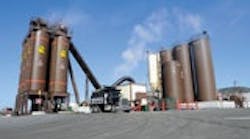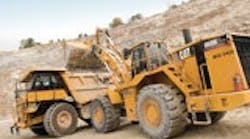The centerpiece of O&G Industries' 84-year-old maintenance program is the company's commitment to oil analysis. To keep the fleet's 700 units reliable and cost effective, Jim Zambero, O&G's vice president of maintenance, says, "we don't ever — ever — take a shortcut.
"We sample every single thing (in the fleet)," Zambero adds. And he means every single fluid reservoir on every single piece of equipment — generating 7,000 oil-analysis reports per year. "We have a lawnmower on the system, plate compactors — a whole operation could stop if a plate compactor stops.
"If we buy a lightweight portable generator, like you'd use around your home, we study the recommended maintenance, install an hour meter, we put it in the system, and it gets sampled so there's no excuses for why it hasn't been serviced.
"If you sample everything," he concludes, "you don't have to worry about anything."
Only about 150 units of the fleet are light trucks and cars. There are about 200 ready-mix trucks and tri-axle dump trucks, and most of the rest of the fleet is heavy off-road equipment.
"So naturally, we have very expensive equipment that operates under the most extreme conditions," says Zambero. "Used-oil analysis is a must, based upon many years of experience (Zambero himself has been with the company for 28 years). It is imperative to know what is happening in all components of a piece of equipment.
"If we see any warning signs of a problem, we take immediate corrective action to prevent a minor problem from becoming a costly catastrophe."
O&G uses ExxonMobil's Signum oil-analysis system. Zambero has elected to receive any alerts Signum generates directly via fax at the company's offices.
Those alerts have a major impact on how we plan our day," Zambero says. "I try to check the fax machine regularly during the day (it's in an office on the floor below his). Everybody in the building understands how important those are to our business, though, and they bring them right up as soon as they come in."
If the alert doesn't require immediate attention, it is routed to technicians at the O&G location where the machine is domiciled, "so everybody knows what's going on with the machines they're using," Zambero says.
If the sample is suspicious, but not threatening, Zambero adds a note to the sample report letting the remote service manager know when he'd like to have the compartment sampled again for a follow-up analysis. He also creates what is known around the company as a BOS — a bad oil sample — note in the O&G maintenance-management system. The system automatically creates a work order when the follow-up sample should be taken.
"That's a system we will follow through on," Zambero says. "Sometimes maintenance gets overlooked. It's typically not intentional — just a big company and everybody's busy. But if the work is not done, the system generates a report so we're reminded to call the operation and get that follow-up sample.
"If we get a fax alert that says there's something really urgent happening, like coolant in an engine, we'll stop the machine right away."
"The system has provided dividends in the profitability of our operations," Zambero says. "It also helps with the resale of our used equipment, by confirming its condition."
A conservative estimate of savings directly attributable to the choice of Mobil's Delvac premium lubricants and the oil-analysis program is $180,000 per year. The A service interval for heavy equipment has increased gradually under the watchful eye of oil analysis, from 200 hours to 350 hours. Heavy trucks are serviced at 12,000 miles. Power-transmission oil-drain intervals have been nearly doubled. Hydraulic filters are changed at A services and oil samples are analyzed every 1,000 hours. There is no preset hydraulic oil-change interval.
Oil analysis ensures that O&G repairs 98 percent of components before failure, saving significantly on parts costs and downtime.
"Routine used-oil analysis provides us with advanced warning of developing problems in our equipment," Zambero says. "On numerous occasions, we have discovered fuel-dilution problems, coolant leaks, air-intake problems, and adverse-wear situations during their developmental phase. This provides us with additional time to schedule replacement equipment for a jobsite, order in parts, and schedule the maintenance repairs.
"That has dramatic value," Zambero says. "It frees up manpower, reduces repair costs, increases equipment utilization and availability — it is a cornerstone of our maintenance program."
"You have to look at the average life of a piece of equipment [like the one you just repaired before failure]," says Scott Stonecipher, ExxonMobil lubrication engineer and representative to O&G. "If oil analysis helps you find a coolant leak at one-third of the life of a machine, you saved two-thirds of the life of that engine."
Faithfully recorded trends in component condition have also simplified warranty claims.
"We have been able to go back to the OEM to document equipment problems that were only starting to grow while under warranty but became major problems out of warranty," Zambero says. Encountering only two or three such events each year, the records can save a bundle. "With the oil-analysis history to show that the trend started while the machine was still under warranty, manufacturers will stand behind it."
Being able to show prospective buyers the quality of service a used machine has received at O&G and the condition of the internal components also brings a premium for O&G's used equipment.
"When you go into the office and bring out the oil-analysis results on every component on the machine from when that machine was brand new, it gives them some kind of comfort level that the machine is in good working condition," Zambero says. "It adds a lot of value at resale."






